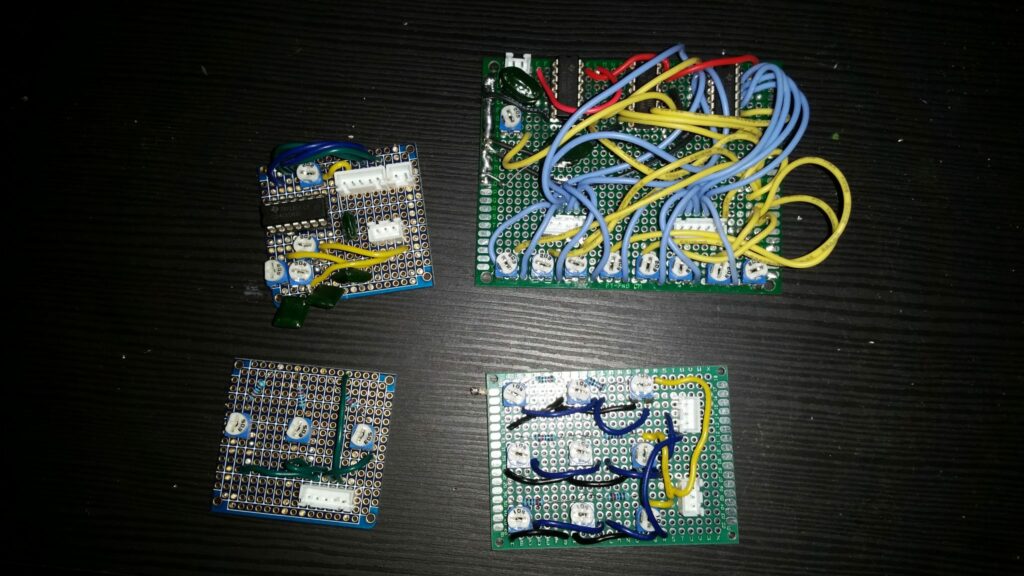Here’s a few synthesizer circuits I’ve made lately. There’s a lot of simple circuits for synth design that are ripe for experimentation, usually under the name of “lunetta” synthesizers or CMOS synthesizers on google, using common digital logic chips to make audio circuits and noisemakers.

The largest is a hex inverter oscillator used as a clock, into a frequency divider, then the outputs of the divider ran into a multiplexer in a way that it counts through the 8 steps controlled by the tiny screwdriver controlled potentiometers. There’s a wiring issue making pots 2 and 3 control the entire pitch of the sequence, but I kinda like it. I just wish I knew why it was doing that – I don’t see anything wired incorrectly, but I used stranded wire with point to point board and it’s possible some of it got caught in the holes and might be shorting. but glitches is part of why I like this set up, I could do all of this in software and midi a lot easier, but it’s just not the same. for this one in particular, it being broken works as an advantage – if you speed the clock up to audio rate, the sequence pretty much turns into a basic wavetable synth. a coarse and fine pot for clock speed would make this a lot more useful.
The small one with 4 knobs is 4 oscillators and 2 inverters. This is too small and needs to be rebuilt, two of the oscillators don’t work and need to be rewired, but it’s all cramped together so close that I can’t reasonably fix it. It still works good enough to test the next two circuits.
The other two, with 9 and 3 pots, are two passive mixers: an experimental matrix mixer, and a normal 3 input mixer.
These all use tiny potentiometers and little header pins instead of full size pots and jacks, because it hardly takes up any room – full sized pots + a faceplate + jacks for output take up a lot of space. I crammed most of these into too small of an area, so troubleshooting them can be tough – but most of the issues are just newbie mistakes and the downsides of using the wrong type of board to put the circuit together. the large board was point to point and a huge headache, and uses waaaaay too many wires, but I kinda like it (I was in the mood of solder work = a form of art at the time, but now it just feels wasteful when a proper board is so much less wiring (and shorting issues related to it))
I’ve got lots more parts on the way, I knew getting back into this hobby was a bad idea, heh. I think I’ve spent at least 500 bucks in the past few months replacing all of my old electronics parts that got ruined in my leaky shed.
I’d really like to buy a eurorack modular synthesizer setup, they are super expensive for what they are but adapting these circuits to that format doesn’t seem like it’d be too tough. I’d also like to build an amp for my synth stuff (I don’t wanna destroy my Roland JC-77 with bleeps and bloops, I push it enough running a bass into it), and a chorus + flanger + phaser for my short scale 6 string bass thing.

BONUS PICTURE OF A DOG. This is Sophie, I got her a few months ago from a local rescue. She’s wonderful, I wish I knew more about little dogs long ago, I figured they were all just like chihuahuas or terriers. She’s more mellow than most cats I’ve met – as long as you aren’t a poodle, anyway, hah. She does not think highly of fancy poodles and will bark at them, it’s kinda funny really. I don’t know what they did to offend her.